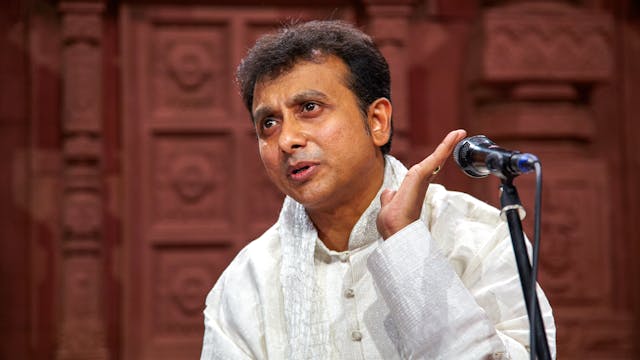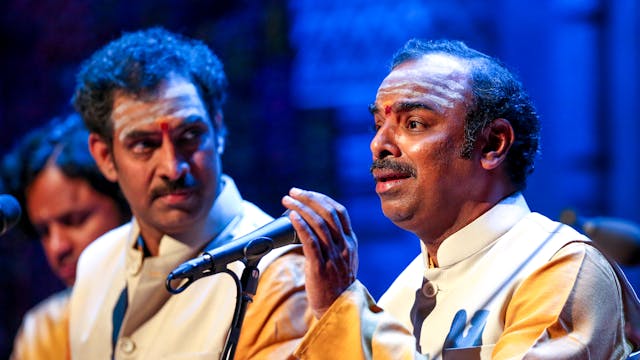Jyotsna Srikanth | Ragam Amritavarshini
Carnatic Tradition
•
12m
Recorded at Darbar Festival 2007, on 15th April, at the Phoenix Theatre, Leicester.
Musicians:
- Jyotsna Srikanth (violin)
- Neyveli Venkatesh (mridangam)
- RN Prakash (ghatam and khanjira)
Raag Amritavarshini, Composition by Mutthiah Bhagavatar (1877-1945) in Rupak talam
This beautiful piece in Raag Amritavarshini is a composition by Mutthiah Bhagavatar, a renowned Carnatic classical composer from the 20th century. Bhagavatar is also credited with the creation of 20 ragas in the Carnatic system.
Before beginning her recital, Dr. Srikanth explains that Amritavarshini is a raga believed to invoke the rains. She also informs the audience that the rhythmic cycle of rupak talam to which it is set, is a 6-beat cycle in the Carnatic system unlike the Hindustani rupak which is set to a 7-beat cycle.
Dr. Srikanth portrays Amritavarshini with an elaborate alapana overflowing with the pathos and devotional vignettes of the raga. The composition is performed with remarkable transposition of vocal
embellishments along with virtuosic instrumental nuances. Dr. Srikanth’s elaboration of the raga in the swarakalpanas is commendably poetic.
The mridangam and ghatam resonate beautifully with each other, making the rhythm cascade and interact intricately with the song.
Venkatesh was born in a remote and non-descript, industrial town in southern India called Neyveli. But it was music that brought him out of its confines and made him a globe-trotting performer in all the five continents. He has learned mridangam from his father, A.S. Balaraman and then took advanced training from Ramanathapuram M.N. Kandaswamy and has gone on to become one of the finest mridangam players of India.
Prakash’s accompaniment adds beautiful textures to this song. Born and trained in India, Prakash is one of the leading UK-based Carnatic percussionists who also holds an important position as faculty in the London School of Carnatic Music.
Raag Amritavarshini was created in the early nineteenth century by Muthuswami Dikshitar. It is an audava ragam (pentatonic scale) and a janya (derived scale) of the 66th melakarta, Chitrambari. It is believed that Amritavarshini causes rain and that the Carnatic composer Muthuswami Dikshitar brought rain at Ettayapuram, Tamil Nadu, India by singing his composition, ‘Aananda Amrutakarshini Amrutavarshini’.
This raga does not contain risabha and dhaivata. It is a symmetric pentatonic scale. The notes used in this scale are shadja, antara gandhara, prati madhyama, panchama and kakali nisadha,
Up Next in Carnatic Tradition
-
P. Unnikrishnan | Hamsanandi
Recorded at Darbar Festival 2011, on 22nd April, at the Phoenix Theatre, Leicester.
Musicians :
- P. Unnikrishnan (vocal)
- Jyotsna Srikanth (violin)
- Bangalore Praveen (mridangam)
- RN Prakash (ghatam)
- Priya Prakash (tanpura)Raag Hamsanandi, Thillana in Adi talam
Composed by Ca... -
Malladi Brothers | Salaga Bhairavi
Filmed at Darbar Festival 2018, on 26th October, at Milton Court Concert Hall, at the Barbican Centre, London.
Musicians :
- Malladi Sreeramprasad (vocal)
- Malladi Ravikumar (vocal)
- Lalgudi Vijayalakshmi (violin)
- Trichy Sankaran (mridangam)
- Giridhar Udupa (ghatam)
- P... -
Aruna Sairam | Raag Lalita
Recorded at Darbar Festival 2009, on 3rd April, at the Purcell Room of London's Southbank Centre.
Musicians:
- Aruna Sairam (vocals)
- Jyotsna Srikanth (violin)
- Patri Satish Kumar (mridangam)
- RN Prakash (ghatam)
- Priya Parkash (tanpura)Raga Lalita, Composition by Muthuswamy Diks...



